‘It costs $4 per person per day to put three plates on the table, and more than 130 million Latin Americans do not have that amount’
Lola Castro, director of the U.N. World Food Program in Latin America and the Caribbean, calls for an urgent increase in climate funds and debt swapping to devote resources to adaptation and mitigation

Lola Castro is a Spanish woman who has traveled the entire planet with one mission: to end hunger. As the current regional director of the World Food Program in Latin America and the Caribbean, she is based in Panama, but for three decades she has worked in “all continents.”
Today, the need to fight hunger is everywhere. The wars in Ukraine and the Middle East, the Covid-19 pandemic and the climate crisis have had a negative impact around the world, “especially in the southern hemisphere,” she points out. Between 691 and 783 million people did not have enough food last year; 122 million more than in 2019, according to the latest UN food security report. This is the sixth consecutive year that the number of hungry people increases. “It is very sad. We were making progress,” she laments. The news regarding food security are not good, either: 2.4 billion people wake up every day without knowing if they will have something to eat. Of them, many of those who manage to put a plate on the table cannot even think about a varied, nutritious menu.
The current crises are a perfect storm that is hitting Latin America and the Caribbean hard, Castro emphasizes. Quite literally, because the adverse effects of climate change — from droughts to hurricanes — are affecting this region, which also suffers from high rates of inequality and poverty. The pandemic increased that statistic even more; today the basic food basket is so expensive that 131 million Latin Americans cannot afford a healthy diet. For this reason, mobilizing resources to adapt to these phenomena is vital for the region’s inhabitants. Their sustenance depends on it. Castro went recently to Spain to speak about this at a conference at Casa de América, in Madrid.
Question. Besides people, what else does hunger kill?
Answer. I’m going to answer with an example. If I am a seven-year-old girl and I go to school to learn, in order to become a mayor in my community, a doctor, a nurse or an architect when I grow up, and all they can give me to eat at home is tea or coffee, then I get to school and I’m so hungry that I don’t understand what my teacher is explaining; I can’t learn anything because my stomach doesn’t let me. Basically, hunger is killing my future as a productive woman. It is killing my development as a healthy, energetic person, capable of forming a family that will grow with me. It’s killing my hope of getting out of poverty.
Q. What is the food landscape in Latin America and the Caribbean today?
A. We have structural problems that have to do with poverty and social marginalization, especially of indigenous peoples and afro-descendants, who are much further behind in food and nutritional security indicators. For example, in Guatemala, chronic malnutrition affects on average 48% of the population. If you go to Huehuetenango, where people of Mayan origin live, you will find up to 85%.
Q. What does this high rate entail?
A. Chronic malnutrition is harder to see. It is detected when people did not have adequate micronutrients in the mother’s womb and during the first thousand days of life. This makes them grow less and, worse, their internal organs are less developed, which entails a great cost for both health systems and families, because they will not be able to develop their full potential.
Q. The region was making great progress in the fight against this evil, but it has slowed down. Are governments sufficiently aware?
A. From 3 to 16% of the gross domestic product is lost due to chronic malnutrition in our Latin American and Caribbean countries. When you are a government and you know that you are going to lose millions of dollars a year because you have not addressed this problem, you want to invest, and many are doing it with good results. But permanent crises prevent governments from supporting social protection systems that last.
Q. In fact, millions cannot afford a healthy diet.
A. The problem is that the cost of a healthy diet has risen enormously. It now costs $4 per person per day to put three plates on the table at home, and more than 130 million people do not have that amount. In eight countries where we operate there is food inflation of more than double digits. Households cannot afford it, especially the most vulnerable, those with less income, lower salaries, minimum wages. Another problem we have is obesity, due to the change in diets; we consume junk food that is full of sugar. That also needs to be changed.

Q. You are meeting more and more with environment ministers. Why?
A. Food security and the climate crisis are increasingly related. And hurricanes, droughts, rising seas and the loss of forests greatly affect the region. In Nicaragua, last year we had a hurricane, Julia, that passed from the Atlantic to the Pacific, which is not a normal route, or Ian in eastern Cuba, and now with the El Niño phenomenon the entire region of Central and South America is extremely affected. The climate crisis affects communities, people and homes, leaving them in poverty. That’s why we see big migrations.
Q. What message are you taking to the next climate summit, COP28, in November?
A. We must ensure that climate funds are bigger, and we have to do it now, because the climate crisis is now. We have countries in the region that are going to be highly indebted, especially in the Caribbean; a financial innovation could be debt swapping for adaptation and mitigation activities.
Q. What is adaptation and mitigation, in practice?
A. Let’s say you live in a drought area in Guatemala and your corn crop doesn’t grow because it doesn’t rain when the corn germinates. Well, there are options: planting other cereals that are more resistant to drought, like sorghum, or tubers such as cassava, which are also used to produce flour. Then there is the issue of having home water collection systems. And finally, foresight. We know what is going to happen. There are so many satellites and weather units in the world that we can make predictions. And hiring insurance. In Europe, we all have our houses or cars insured; if a farmer in Central America or the Caribbean is insured and loses her harvest, she will be able to plant again.
Sign up for our weekly newsletter to get more English-language news coverage from EL PAÍS USA Edition
Tu suscripción se está usando en otro dispositivo
¿Quieres añadir otro usuario a tu suscripción?
Si continúas leyendo en este dispositivo, no se podrá leer en el otro.
FlechaTu suscripción se está usando en otro dispositivo y solo puedes acceder a EL PAÍS desde un dispositivo a la vez.
Si quieres compartir tu cuenta, cambia tu suscripción a la modalidad Premium, así podrás añadir otro usuario. Cada uno accederá con su propia cuenta de email, lo que os permitirá personalizar vuestra experiencia en EL PAÍS.
¿Tienes una suscripción de empresa? Accede aquí para contratar más cuentas.
En el caso de no saber quién está usando tu cuenta, te recomendamos cambiar tu contraseña aquí.
Si decides continuar compartiendo tu cuenta, este mensaje se mostrará en tu dispositivo y en el de la otra persona que está usando tu cuenta de forma indefinida, afectando a tu experiencia de lectura. Puedes consultar aquí los términos y condiciones de la suscripción digital.
More information

Hunger, a complex web of vulnerabilities
Archived In
Últimas noticias
Most viewed
- Sinaloa Cartel war is taking its toll on Los Chapitos
- Oona Chaplin: ‘I told James Cameron that I was living in a treehouse and starting a permaculture project with a friend’
- Reinhard Genzel, Nobel laureate in physics: ‘One-minute videos will never give you the truth’
- Why the price of coffee has skyrocketed: from Brazilian plantations to specialty coffee houses
- Silver prices are going crazy: This is what’s fueling the rally










































